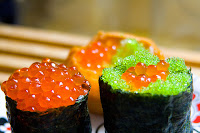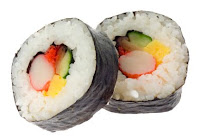Menu Taste and Personal Experience:
 |
| Sushi Boat |
Menu Description:
HistoryThe traditional form of sushi is fermented fish and rice, preserved with salt in a process that has been traced to Southeast Asia, where it remains popular today. The term sushi comes from an archaic grammatical form no longer used in other contexts; literally, "sushi" means "it's sour", a reflection of its historic fermented roots.
 |
| Sushi Platter |
Contemporary Japanese sushi has little resemblance to the traditional lacto-fermented rice dish. Originally, when the fermented fish was taken out of the rice, only the fish was consumed and the fermented rice was discarded. The strong-tasting and smelling funazushi, a kind of narezushi made near Lake Biwa in Japan, resembles the traditional fermented dish. Beginning in the Muromachi period (AD 1336–1573) of Japan, vinegar was added to the mixture for better taste and preservation. The vinegar accentuated the rice's sourness and was known to increase its shelf life, allowing the fermentation process to be shortened and eventually abandoned. In the following centuries, sushi in Osaka evolved into oshi-zushi. The seafood and rice were pressed using wooden (usually bamboo) molds. By the mid 18th century, this form of sushi had reached Edo (contemporary Tokyo).
The contemporary version, internationally known as "sushi", was created by Hanaya Yohei (1799–1858) at the end of the Edo period in Edo. The sushi invented by Hanaya was an early form of fast food that was not fermented (therefore prepared quickly) and could be eaten with one's hands at a roadside or in a theatre. Originally, this sushi was known as Edomae zushi because it used freshly caught fish in the Edo-mae (Edo Bay or Tokyo Bay). Though the fish used in modern sushi no longer usually comes from Tokyo Bay, it is still formally known as Edomae nigirizushi.
Nigirizushi
 |
| Nigiri Sushi |
 |
| Gunkanmaki Photo by Phu Son Nguyen Sushiday.com |
 |
| Temari Sushi Photo by whatsonxiamen.com |
Makizushi
 |
| Maki Sushi |
 |
| Futomaki Photo by dineouthere.com |
 |
| Hosomaki |
 |
| Temaki |
Uramaki (inside-out rolls) is a medium-sized cylindrical piece, with two or more fillings. Uramaki differs from other makimono because the rice is on the outside and the nori inside. The filling is in the center surrounded by nori, then a layer of rice, and an outer coating of some other ingredients such as roe or toasted sesame seeds.
Oshizushi
Oshizushi (pressed sushi), is a pressed sushi from the Kansai Region, a favourite and specialty of Osaka. A block-shaped piece formed using a wooden mold, called an oshibako. The chef lines the bottom of the oshibako with the toppings, covers them with sushi rice, and then presses the lid of the mold down to create a compact, rectilinear block. The block is removed from the mold and then cut into bite-sized pieces.
Inarizushi
Inarizushi
 |
| Inari Sushi |
Chirashizushi
 |
| Chirasi Sushi |
Narezushi
 |
| Nare Sushi |
Western-style sushi
 |
| Western Style Sushi |
The increasing popularity of sushi around the world has resulted in variations typically found in North America and Europe, but rarely in Japan. Such creations to suit the Western palate were initially fueled by the invention of the California roll. A wide variety of popular rolls has evolved since.
Condiments
Sushi is commonly eaten with condiments. Sushi may be dipped in shōyu, soy sauce, and may be flavored with wasabi, a piquant paste made from the grated root of the Wasabia japonica plant. However, some consider the use of condiments with sushi to be rude, as it implies that the chef's original preparation was inadequate.
 |
| Gari - Japanese Pickled Ginger |
Gari, sweet, pickled ginger is eaten with sushi to both cleanse the palate and aid in digestion. In Japan, green tea (ocha) is invariably served together with sushi. Better sushi restaurants often use a distinctive premium tea known as mecha. In sushi vocabulary, green tea is known as agari.
Sushi Rice Recipe
Menu Ingredients:
3 cups uncooked sushi or sticky or plain rice3 cups water
½ cup rice/white/brown vinegar
½ cup sugar
1 teaspoon salt
Menu Directions:
1. Wash the rice and rinse thoroughly. |
| Sushi |
3. Meanwhile, mix together the rice vinegar, sugar and salt in a small saucepan; cook over medium heat until sugar has dissolved. Allow to cool.
4. Put the cooked rice into a large mixing bowl; pour the vinegar sauce over the hot rice and mix. Allow to cool slightly before using in sushi recipes.
For other sushi recipes, please have a look at the sushi section of Japanese Menu.
Menu Related Videos:
How to make Japanese Menu Temaki Sushi
Sushi restaurant at Tokyo
Tokyo sushi train
Sushi Boat
Menu Sources and References:
- http://www.dineouthere.com
- http://www.sushiday.com
- http://www.whatsonxiamen.com
- http://en.wikipedia.org/wiki/sushi (GNU Free Documentation License)
1 comments:
I'm starving in English class and I WANT C:
Post a Comment